Photo / Video News & Reviews
Photographing Responsibly: A Beginner’s Guide

Next time you’re diving with an experienced underwater photographer, take a moment to really look at how they conduct themselves and their placement in the water. Notice anything in particular? You might notice how they hover over the reef, sand or muck without disturbing a single grain, rock or soul. You might also notice how effortlessly they glide through the water and how still they perch when stalking their subject. To many new photographers, this might seem totally impossible but all it takes is a few simple tricks and some practice.
If you’re in the water and photographing the coral scapes or wildlife, chances are it’s because you find the behaviours intriguing or see a beauty in the environment that you want to capture and share. If you’re a new or less experienced photographer, you may also be experiencing some of the challenges around maintaining buoyancy and managing your equipment, all while trying to approach and photograph a subject.
It’s imperative as divers that we protect and maintain these marine environments, leaving them as if we were never there. The ocean is the largest ecosystem and supports the largest volume and variety of life on earth. Not to mention that oceans contribute a large volume of the air we breathe, the food we eat and reduce the impact of climate change by absorbing carbon dioxide from the atmosphere. Pretty impressive, right?
In this blog I want to share with you four key lessons I have learnt that have improved the way I dive, the quality of the photographs I produce, and the way I’ve learnt to minimise my impact on the dive sites I visit.
1: Be selective with your gear
Every photographer suffers from the fear of missing out. It’s always the way, you set up your macro lens and see a great wide angle scene. You set up for wide angle and find a rare and beautiful nudibranch. It can be tempting to take down every diopter you own, your snoot, a mirror… the works.
In reality, this can be really distracting and ultimately get in your way. If you’re fussing with gear constantly, you will find it harder to get into a rhythm with your shots and also run the risk of losing pieces of expensive equipment if you’re constantly screwing, unscrewing, clipping and unclipping. Less is definitely more!
I was shooting cryptic teardrop crabs with my fluorescent kit last year. My strobes, focus light, mask and lens all had special filters to capture the beautiful phenomenon. While shooting the crabs, I found a clown crab. Unfortunately, it wasn’t possible to capture him using the fluoro gear. By the time I removed the filters and fussed with my mask, he was long gone. Not to mention, I had four pieces of expensive equipment sitting on the sand next to me, in the dark, that I had to reassemble onto my camera. You can easily see how this could have ended badly.

It’s much easier, especially when you’re newer to underwater photography, to focus on one style of shot and stick with it. Make a plan using the technique you’d like to master and focus your energy on getting shots you’re really proud of. One great shot is always more satisfying than dozens of ‘I wish I’d done’ shots. Look at the masters, you’ll notice that they keep things simple and focus on one thing at a time. Coincidence? I think not!
Most importantly and to the spirit of this piece, if you’re constantly distracted with your gear, you may not be paying as much attention as you should to your buoyancy and placement in the water. Before you know it, you’ve got a fin or a hand somewhere it doesn’t belong. Constantly evaluating where your body is, in relation to the reef or muck, is critically important to protecting yourself from stings and bites as well as protecting the critters and corals around us.
Really, limiting yourself to a few essentials produces the best outcome for you as a photographer and allows you the mental space to become more aware of your surroundings.
2: Make sure you’ve got your buoyancy just right
When you buy your first underwater camera, it can be tempting to jump right in and get shooting. Unfortunately for the majority of us, mastering buoyancy can be a real challenge and doesn’t come right away.
To get the most out of your photography, having control of your breathing and limbs is essential to get the best shots. Correct buoyancy improves the way you approach a subject and reduces motion blur you introduce through the movement of your body from constant kicking and erratic breathing. Not to mention that if you can control your breath and body movements your air will last longer, allowing you more bottom time for shooting.
Mastering your buoyancy, most importantly, allows you to hover over the reef, sand or muck you are trying to photograph with minimal impact on the environment. Plus, you will be a better dive buddy (no one likes the person who kicks sand!).
My advice is to have your buoyancy mastered and under control before you consider getting in the water with a camera. Get the basics right before you try and add another level of complexity to your underwater experience.
While you’re mastering your buoyancy, use your time without distraction wisely. Observe specific behaviours you may find interesting to shoot in the future, try and understand the reef scape and the places your favourite critters love to hide out. After all, knowing where to look and recognising interesting behaviours can ultimately deliver some incredible shots.
3: Check and check again
When you’ve found a subject you want to photograph, stop and take a moment to evaluate where it is and what’s around it. It might be tempting to start shooting immediately, however taking an extra moment before you get stuck in will make a big difference to your comfort underwater and ensuring that you are leaving no sign of your presence behind.
Is your subject on the sand? It might be tempting to see a sandy bottom near a subject and assume you’ve got the all clear. Take a quick moment to think about what could be really well camouflaged or even buried in the sand. Depending on where you’re diving, eels, scorpion or stone fish could be lurking just below the surface. Do a visual inspection of the area, look for tell-tale holes and mounds of sand which could indicate the presence of a living soul. Avoid these areas to ensure you’re not disrupting any wildlife or running the risk of stings and injury to yourself. If you believe the area is clear, use a metal diving stick and gently run it over the sand as a final measure.

Is your subject on the reef? This could be a trickier environment to navigate. Chances are you’re surrounded by soft or hard corals with a diverse range of marine life around you. If your only option is to hover above the subject, relying entirely on your buoyancy, check around you for any current and nearby coral or rocky structures. You don’t want current pushing you into these while you’re trying to shoot. Look up consistently between shots and adjust your position in the water frequently to ensure that you’re maintaining a safe distance between yourself, your subject and the reef.
If you’re lucky and there is some sand or bare rock near you, you can take advantage of these to anchor yourself. Again, visually inspect the area. If it looks clear, you can take two fingers and gently place them on the rock or sand in order to stabilize yourself and get the shot. If you are relying on a rock, really take the time to make sure there are no little critters living in the cracks and crevices.
My final advice is to talk to your dive guide or shop about any nasties you need to keep an eye out for or any critters that may be buried and lurking underneath the sand. It’s important to really understand the wildlife you are diving with to avoid any negative encounters.
4: Evaluate the risk
Really think about where your subject is located and evaluate whether you can realistically take the photograph without causing damage. You know and understand your own skills and abilities better than anyone else so be honest with yourself.
If you find a really beautiful nudibranch that you know is quite common… but sticking up in the air, surrounded by a large patch of soft corals, under an outcrop with strong current, really think to yourself if the shot is worth it. It may be better to wait for a subject that’s nicely facing you, out in the open or in a less densely populated area. You’ll get a better shot and mother nature will thank you for your consideration. No matter how great a shot can be, remember, safety first.
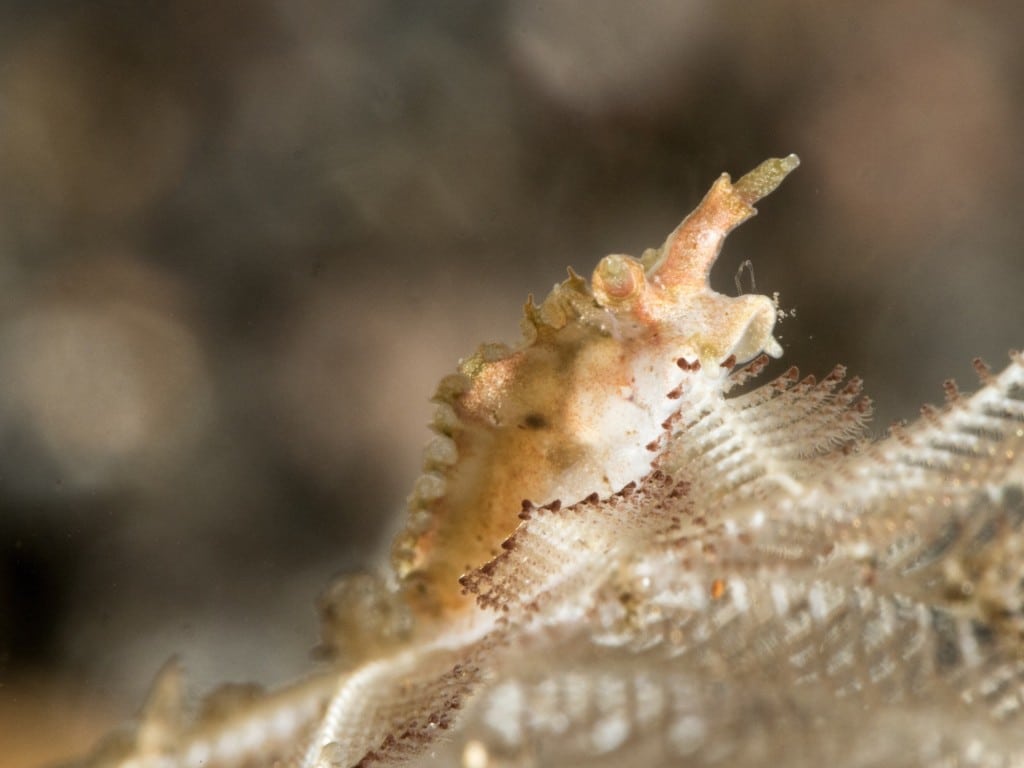
I hope you’ve found these tips useful. These are all lessons I’ve learned myself as I’ve started my journey with underwater photography. It isn’t always easy to do the right thing but in the long-term it’s worth thinking about the impact we have, as divers and photographers, on the environment.
Check out more of Miranda-Clare’s photos on Instagram @divingphotos or visit her website www.mirandaclare.com.
Blogs
Diver Discovering Whale Skeletons Beneath Ice Judged World’s Best Underwater Photograph
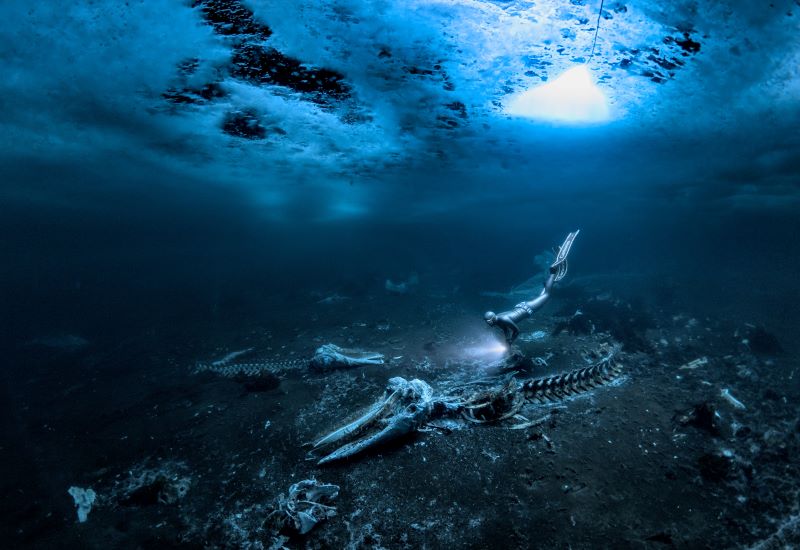
An emotive photograph showing a freediver examining the aftermath of whaling sees
Alex Dawson from Sweden named Underwater Photographer of the Year 2024. Dawson’s
photograph ‘Whale Bones’ triumphed over 6500 underwater pictures entered by underwater
photographers from around the world.
“Whale Bones was photographed in the toughest conditions,” explains chair of judging
panel Alex Mustard, “as a breath-hold diver descends below the Greenland ice sheet to bear
witness to the carcasses. The composition invites us to consider our impact on the great
creatures of this planet. Since the rise of humans, wild animals have declined by 85%. Today,
just 4% of mammals are wildlife, the remaining 96% are humans and our livestock. Our way
needs to change to find a balance with nature.”
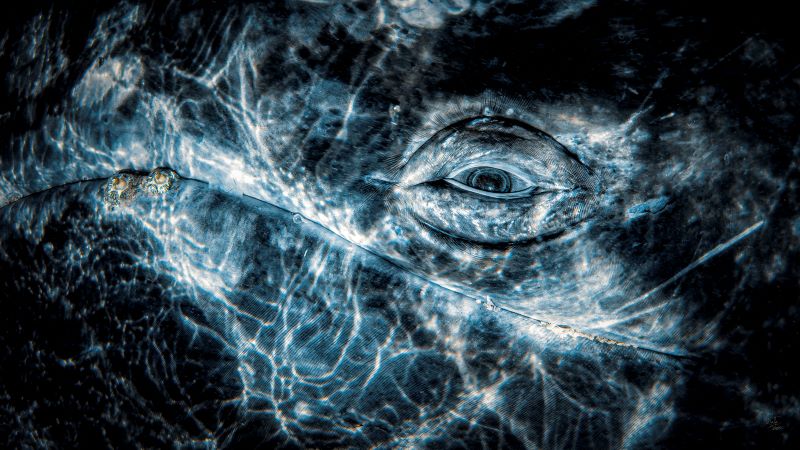
Photo: Rafael
Fernandez Caballero
Whales dominated the winning pictures this year with Spanish photographer Rafael
Fernandez Caballero winning two categories with his revealing photos of these ocean giants:
a close up of a grey whale’s eye and an action shot of a Bryde’s whale engulfing an entire bait
ball, both taken in Magdalena Bay, Baja California, Mexico. Fernandez Caballero took ‘Grey
Whale Connection’ while drifting in a small boat, holding his camera over the side in the water
to photograph the curious whale. ‘The End Of A Baitball’ required Fernandez Caballero to dive
down and be in exactly the right place at the moment the whale lunged. “The photo shows
the high speed attack,” he said, “with the whale engulfing hundreds of kilograms of sardines
in one bite — simply unforgettable to see predation on such a scale.”
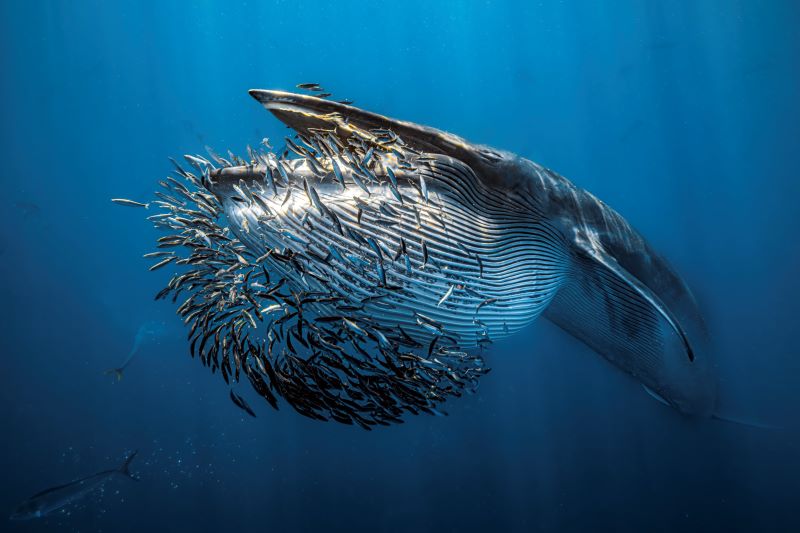
Photo: Rafael
Fernandez Caballero
Lisa Stengel from the United States was named Up & Coming Underwater Photographer of the Year 2024 for her image of a mahi-mahi catching a sardine, in Mexico. Stengel used both a very fast shutter speed and her hearing to catch the moment. “If you listen there’s an enormous amount of sound in the ocean,” she explained. “The action was too fast to see, so I honed in on the sound of the attacks with my camera to capture this special moment.”
“It is such an exciting time in underwater photography because photographers are capturing such amazing new images, by visiting new locations and using the latest cameras,”
commented judge Alex Mustard. “Until this year I’d hardly ever see a photo of a mahi mahi,
now Lisa has photographed one hunting, action that plays out in the blink of an eye.”
The Underwater Photographer of the Year contest is based in the UK, and Jenny Stock,
was named as British Underwater Photographer of the Year 2024 for her image “Star
Attraction”, which finds beauty in species of British wildlife that are often overlooked.
Exploring the west coast of Scotland, Stock explained “in the dark green depths my torch
picked out the vivid colours of a living carpet of thousands of brittle stars, each with a
different pattern. I was happily snapping away, when I spotted this purple sea urchin and I
got really excited.”
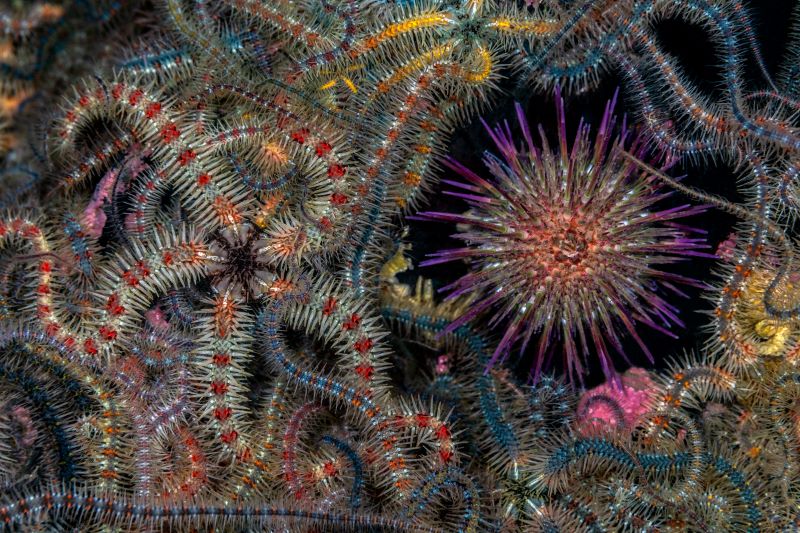
Photo: Jenny Stock
In the same contest, Portuguese photographer, Nuno Sá, was named ‘Save Our Seas
Foundation’ Marine Conservation Photographer of the Year 2024, with his photo ‘Saving
Goliath’, taken in Portugal. Sá’s photo shows beachgoers trying to save a stranded sperm
whale. The picture gives us hope that people do care and want to help the oceans, but also
warns us that bigger changes are needed. “The whale had been struck by a ship and its fate
was sealed,” explains Sá. “An estimated 20,000 whales are killed every year, and many more
injured, after being struck by ships-and few people even realise that it happens.”
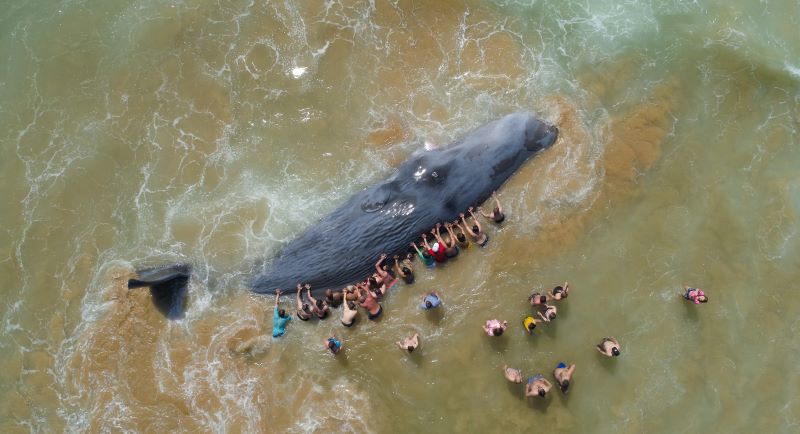
Photo: Nuno Sá
More winning images can be found at www.underwaterphotographeroftheyear.com.
About Underwater Photographer of the Year
Underwater Photographer of the Year is an annual competition, based in the UK, that celebrates photography beneath the surface of the ocean, lakes, rivers and even swimming pools, and attracts entries from all around the world. The contest has 13 categories, testing photographers with themes such as Macro, Wide Angle, Behaviour and Wreck photography, as well as four categories for photos taken specifically in British waters. The winners were announced in an award ceremony in Mayfair, London, hosted by The Crown Estate. This year’s UPY judges were experienced underwater photographers Peter Rowlands, Tobias Friedrich and Dr Alexander Mustard MBE.
Header image: Underwater Photographer of the Year 2024 winner Alex Dawson
News
World’s Best Underwater Photographers Unveil Breathtaking Images at World Shootout 2023
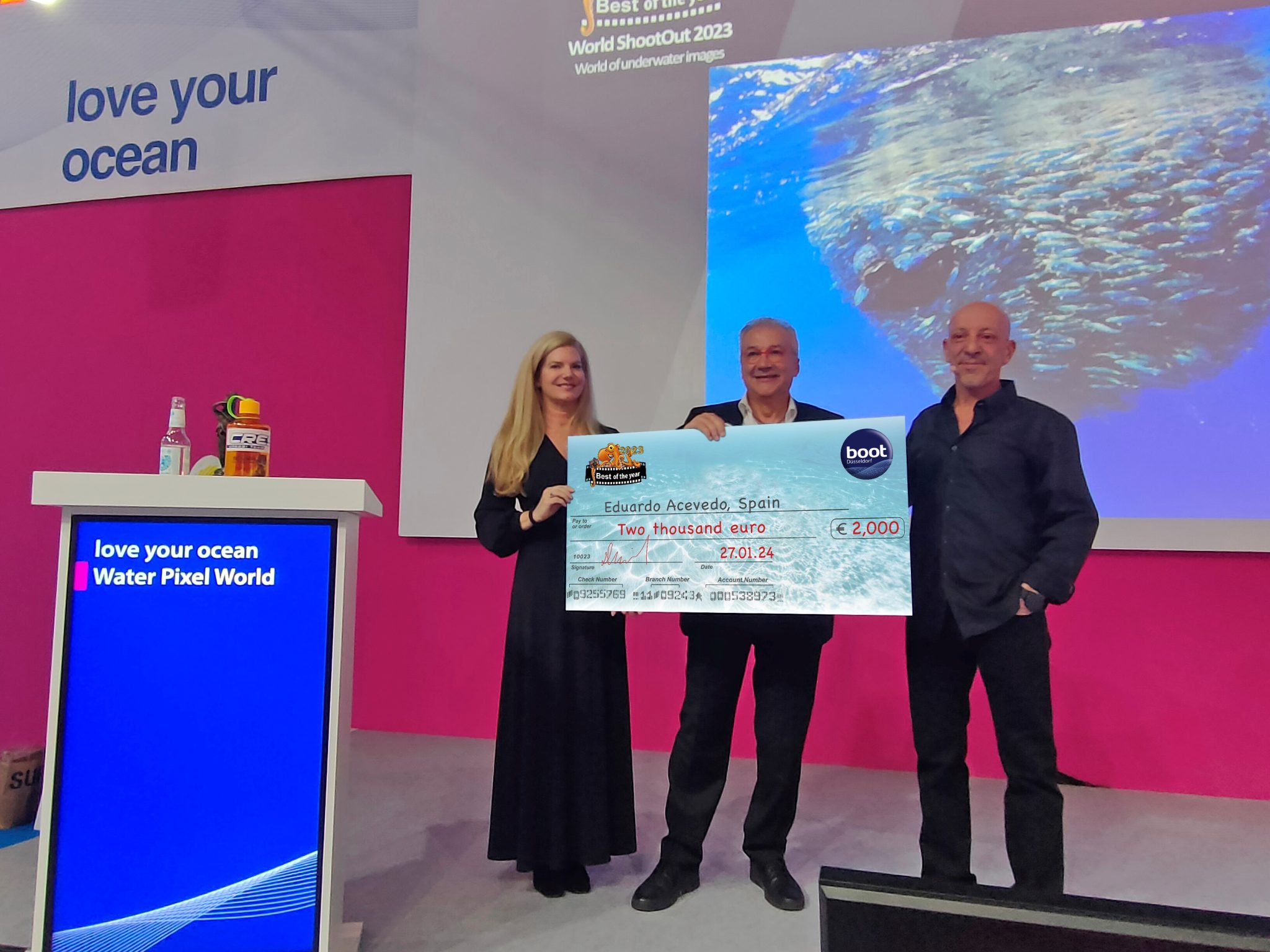
The winners of the prestigious World Shootout 2023 underwater photography competition were announced at this year’s BOOT Show, captivating audiences at the world’s largest diving and water sports exhibition in Dusseldorf, Germany. Hundreds of photographers from 54 countries competed across nine categories, pushing the boundaries of creativity and technical skill.
Grand Prize Winners
- Picture of the Year: Spanish photographer Eduardo Acevedo “secured” the top Honor with the prestigious prize the “boot Dusseldorf Director’s Prize, earning an Andromeda statuette and a €2,000 cash prize.
- Best 5 Images Portfolio: Luc Rooman from Belgium triumphed in this category, winning a dream 4-week diving trip for two to Papua New Guinea, valued at $18,900.
- Amateur Photographer: Alexandra Ceurvorst from the USA impressed the judges with her talent, taking home the 1,000 € cash prize award.
Celebrating Diversity and Innovation
This year’s competition saw 11,680 entries from 964 photographers, showcasing a remarkable spectrum of skills and perspectives. From the intricate wonders of Macro photography to the beauty of “Black Water”, the “Underwater Fashion” category added a touch of artistry and innovation, while the ever-important ” Environmental & Conservation” category served as a powerful reminder of the need to protect these fragile ecosystems.
Looking Ahead: AI and Ocean Conservation
World Shootout founder and producer David Pilosof unveiled an exciting addition for the 2024 competition: this year the Environmental category will be focusing on the impact of plastic on our oceans and future.
This category will embrace the potential of AI or other editing software as a tool to amplify the conservation message.
Entrants will submit campaigns of three original underwater photographs dealing with plastic pollution, along with their final AI assistance processing. This innovative approach encourages artistic expression while raising awareness about a critical environmental issue.
Explore the Stunning Collection
Discover the complete album of competition entries by clicking here.
For Low-resolution photos of finalist entries in eight categories, click here.
-

 News3 months ago
News3 months agoHone your underwater photography skills with Alphamarine Photography at Red Sea Diving Safari in March
-

 News3 months ago
News3 months agoCapturing Critters in Lembeh Underwater Photography Workshop 2024: Event Roundup
-

 Marine Life & Conservation Blogs2 months ago
Marine Life & Conservation Blogs2 months agoCreature Feature: Swell Sharks
-

 Blogs2 months ago
Blogs2 months agoMurex Resorts: Passport to Paradise!
-

 Blogs2 months ago
Blogs2 months agoDiver Discovering Whale Skeletons Beneath Ice Judged World’s Best Underwater Photograph
-

 Gear Reviews3 months ago
Gear Reviews3 months agoGear Review: Oceanic+ Dive Housing for iPhone
-

 Marine Life & Conservation2 months ago
Marine Life & Conservation2 months agoSave the Manatee Club launches brand new webcams at Silver Springs State Park, Florida
-

 News3 months ago
News3 months agoWorld’s Best Underwater Photographers Unveil Breathtaking Images at World Shootout 2023
















